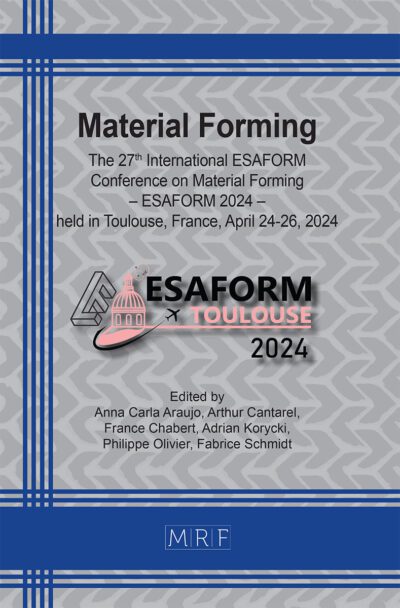Virtual forming based on model calibration from heterogeneous tests
Lisa Germain, Mafalda Gonçalves, Thibault Barret, Antonio Andrade-Campos, Sandrine Thuillier
Abstract. This study focuses on calibrating a mechanical model for a DP600 steel using both quasi-homogeneous and heterogeneous tests. Several sample geometries subject to a uniaxial load were selected and tested experimentally, and a finite element model updating method was used to identify the material parameters of an anisotropic plasticity model, leading to several material parameter sets. Then, the virtual forming of cylindrical cup is considered, using these different parameter sets. The strain and stress states of the mechanical tests used for the model calibration are compared with those of the forming process, to analyse their relevance. The main goal is to check the whole chain from the indicator-based design of heterogeneous tests up to a numerical case study of the forming of cylindrical cups.
Keywords
Heterogeneous Test, Anisotropic Plasticity, Deep Drawing, High Strength Steel
Published online 5/7/2025, 9 pages
Copyright © 2025 by the author(s)
Published under license by Materials Research Forum LLC., Millersville PA, USA
Citation: Lisa Germain, Mafalda Gonçalves, Thibault Barret, Antonio Andrade-Campos, Sandrine Thuillier, Virtual forming based on model calibration from heterogeneous tests, Materials Research Proceedings, Vol. 54, pp 1568-1576, 2025
DOI: https://doi.org/10.21741/9781644903599-169
The article was published as article 169 of the book Material Forming
![]() Content from this work may be used under the terms of the Creative Commons Attribution 3.0 license. Any further distribution of this work must maintain attribution to the author(s) and the title of the work, journal citation and DOI.
Content from this work may be used under the terms of the Creative Commons Attribution 3.0 license. Any further distribution of this work must maintain attribution to the author(s) and the title of the work, journal citation and DOI.
References
[1] N. Souto, A. G. Andrade-Campos and S. Thuillier, Material parameter identification within an integrated methodology considering anisotropy, hardening and rupture, J Mater Process Technol 220 (2015) 157-172. http://dx.doi.org/10.1016/j.jmatprotec.2015.01.017
[2] S. Zhang, L. Léotoing, D. Guines, S. Thuillier, S.L. Zang, Calibration of anisotropic yield criterion with conventional tests or biaxial test, Int J Mech Sci 85 (2014) 142-152 http://dx.doi.org/10.1016/j.ijmecsci.2014.05.020
[3] Y. Zhang, A. Yamanaka, S. Cooreman, T. Kuwabara, S. Coppieters, Inverse identification of plastic anisotropy through multiple non-conventional mechanical experiments, Int J Solids Structures 285 (2023) 112534. https://doi.org/10.1016/j.ijsolstr.2023.112534
[4] F. Pierron, M. Grédiac, Towards Materials Testing 2.0. A review of test design for identification of constitutive parameters from full-field measurements, Strain 57 (2021) e12370. https://doi.org/10.1111/str.12370
[5] M. Gonçalves, A. Andrade-Campos, B. Barroqueiro, On the design of mechanical heterogeneous specimens using multilevel topology optimization, Advances in Engineering Software 175 (2023) 103314. https://doi.org/10.1016/j.advengsoft.2022.103314
[6] M. Gonçalves, A. Andrade-Campos, S. Thuillier, On the topology design of a mechanical heterogeneous specimen using geometric and material nonlinearities, IOP Conf. Series: Materials Sciences and Engineering 1328 (2022) 012055. doi:10.1088/1757-899X/1238/1/012055
[7] M. Gonçalves, B. Guegan, S. Thuillier, A. Andrade-Campos, Experimental investigation of heterogeneous mechanical tests Materials Research Proceedings, Vol. 41, pp 1742-1751, 2024. https://doi.org/10.21741/9781644903131-193
[8] M. Gonçalves, M.G. Oliveira, S. Thuillier, A. Andrade-Campos. Key performance indicators for heterogeneous mechanical tests. Int J Mech Sci 264 (2024) 108821. https://doi.org/10.1016/j.ijmecsci.2023.108821
[9] E.M. Jones, J.D. Carroll, K.N. Karlson, S.L.B. Kramer, R.B. Lehoucq, P.L. Reu PL, D.Z. Turner, Parameter covariance and non-uniqueness in material model calibration using the Virtual Fields Method. Comput Mater Sci 152 (2018) 268–90. http://dx.doi.org/10.1016/j.commatsci.2018.05.037
[10] M. Rossi, F. Pierron, M. Stamborská. Application of the virtual fields method to large strain anisotropic plasticity. Int J Solids Struct (2016) 97–98:322–35. http://dx.doi.org/10.1016/j.ijsolstr.2016.07.015.
[11] M. Conde, Recommendation engine and design techniques for the efficient calibration and selection of mechanical constitutive models, PhD thesis, Universidad de Aveiro, 2024
[12] F. Barlat, J.C. Brem, J.W. Yoon, K. Chung, R.E.Dick, D.J. Lege, F. Pourboghrat, S.H. Choi, E. Chu. Plane stress yield function for aluminum alloy sheets – Part 1: Theory, Int J Plast 19 (2003) 1297–319. http://dx.doi.org/10.1016/S0749-6419(02)00019-0
[13] M. Gonçalves, S. Thuillier, A. Andrade-Campos, Assessing the potential of heterogeneous mechanical tests for sheet metals through experimentally measured full-fields, submitted for publication in Experimental Mechanics (2024)
[14] A. Abedini, C. Butcher, T. Rahmaan, M.J Worswick, Evaluation and calibration of anisotropic yield criteria in shear loading: constraints to eliminate numerical artefacts, Int J Solids Structures 151 (2018) 118-134. http://dx.doi.org/10.1016/j.ijsolstr.2017.06.029
[15] M. Gonçalves, Design of a novel heterogeneous mechanical test using topology optimization for sheet metal characterization, PhD thesis, Universidad de Aveiro, 2024
[16] A. Shrivastava, D.R. Kumar, Simulation of deep drawing of dual phase steel sheets incorporating tribological behaviour predicted by advanced friction modelling, IOP Conf. See.: Mater.Sci. Eng. 1284 (2023) 012047. http://dx.doi.org/10.1088/1757-899X/1284/1/012047













